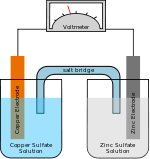Bunsen cell
From Wikipedia, the free encyclopedia

Bunsen's cell
The Bunsen cell is a zinc-carbon primary cell (colloquially called a "battery") composed of a zinc anode in dilute sulfuric acid separated by a porous pot from a carbon cathode in nitric or chromic acid.
Cell details
The Bunsen cell is about 1.9 volts and arises from the following reaction:[1]
- Zn + H2SO4 + 2HNO3 → ZnSO4 + 2 H2O + 2 NO2↑
The cell is named after its inventor, German chemist Robert Wilhelm Bunsen, who improved upon the Grove cell by replacing Grove's platinum cathode with carbon in the form of pulverized coal and coke. Like Grove's battery, Bunsen's emitted noxious fumes.
Bunsen used this cell to extract metals. Henri Moissan used a stack of 90 cells for the electrolysis of hydrogen fluoride to obtain the element fluorine for the first time.
See also
| Wikimedia Commons has media related to Electric batteries. |
References
- ↑ Carhart, Henry Smith (1891). Primary Batteries. Boston: Allyn and Bacon. pp. 179–180. Retrieved 2008-09-13.
Further reading
- Ayrton, W.E.; T. Mather (1911). Practical Electricity. London: Cassell and Company. pp. 183–185.
- Peschel, Karl Friedrich (1846). Elements of Physics. Longman, Brown, Green, and Longmans. p. 82.
- R. Bunsen (1841). "Ueber eine neue Construction der galvanischen Säule". Annalen der Chemie und Pharmacie 38 (3): 311–313. doi:10.1002/jlac.18410380306.
- R. Bunsen (1841). "Ueber die Anwendung der Kohle zu Volta'schen Batterien". Annalen der Physik und Chemie 130 (11): 417–430. Bibcode:1841AnP...130..417B. doi:10.1002/andp.18411301109.
External links
This article is issued from Wikipedia. The text is available under the Creative Commons Attribution/Share Alike; additional terms may apply for the media files.
